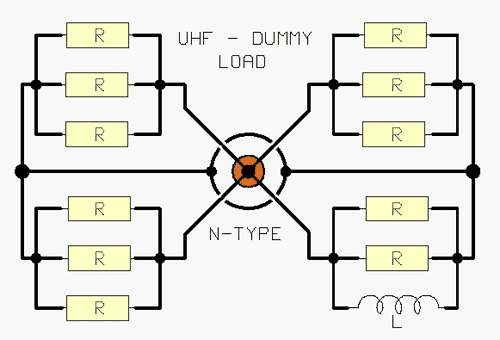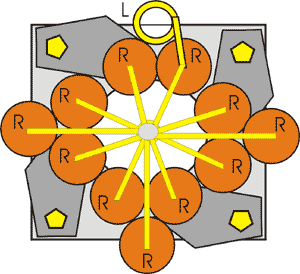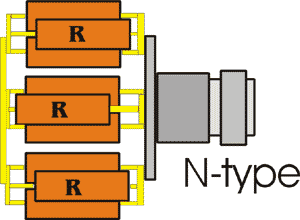Konštruktérom tejto umelej záťaže je Mak, SV1BSX. Viacero zaujímavých konštrukcií, ale nielen to nájdete na jeho stránke: https://www.QSL.net/sv1bsx. TNX Mak!
Dôvody vysokého PSV umelej záťaže
Home made umelá záťaž je obvykle zhotovená paralelným spojením viacerých uhlíkových rezistorov tak, aby sa dosiahol odpor 50 ohm. Takáto konštrukcia dobre poslúži na KV, ale nie na VKV, či UKV (430 – 440 MHz), kde sa znenazdania objaví pri meraní vysoké PSV. Takáto umelá záťaž je potom pre meracie účely nepoužiteľná.
Príčina vysokého PSV je v parazitnej kapacite rezistorov. Obrázok č.1 zobrazuje uhlíkový rezistor. Dva klobúčiky na koncoch keramického telieska sa chovajú ako dve plôšky malého kondenzátora. Paralelným spojením rezistorov sa táto kapacita „násobí“ počtom rezistorov. Katastrofa!
Schéma umelej záťaže

Ak chceme túto nežiadúcu kapacitu eliminovať, je to možné a ľahké s malou indukčnosťou, ktorou stiahneme PSV na 1:1. Na obrázku č.2 je schéma takejto umelej záťaže.
Praktické zapojenie umelej záťaže
Rezistory sú 560 ohm/2W. Použil som jedenásť paralelne spojených rezistorov, aby som dosiahol hodnotu 50 (50,9) ohmov. Celková záťaž je 11x2W = 22W, ale prakticky takáto záťaž na pár sekúnd zvládne aj výkon 100W. To je dostačujúce pre väčšinu meraní s komerčnými zariadeniami, ktorých výstupný výkon je medzi 5 a 35 wattov.


Na obrázku č.3 je praktická konštrukcia umelej záťaže. Ako konektor je použitý panelový N-konektor (samicu). Indukčnosť „L“ tvoria štyri závity 0,8mm drôtu na priemere 3mm v dĺžke vinutia 15mm. Ak nebude PSV optimálne, počet závitov je možné zväčšiť alebo zmenšiť.
Ešte poznámka na záver – takto zhotovená umelá záťaž je vhodná len pre UKV (na VKV bude mať opäť vyššie PSV, povedzme 2:1).
Makis SV1BSX, https://www.qsl.net/sv1bsx
